Throughout all the changes of Australian society, no sport or team has represented more about the country than football and the Socceroos. For 100 years, they’ve held-up a mirror to the nation, while providing a window to the world from the most remote corner.
Australian football has always been a tale of immigration and, inherently, the relationship with workers.
When the first reports of a game played in the country were written in 1829, it wasn’t the gentry taking part but soldiers playing football in Sydney barracks.
The burgeoning coal industry in Newcastle and the Hunter brought migrants from Scotland and northern England where football had taken grip. Clubs like Minmi Rangers and Adamstown Rosebud sprouted in the late 1800’s.
When the local game became international in 1922, it was workers of Irish, Scottish and English stocks that formed Australia’s first national team. Eight from Queensland, eight from New South Wales were selected to play two games against New Zealand. They wore light blue and maroon kits in homage to the two states but in absence of a truly national representation, the tour was a disappointment. New Zealand won the series, beating Australia 3-1 before holding the tourists to a 1-1 draw in the second match.
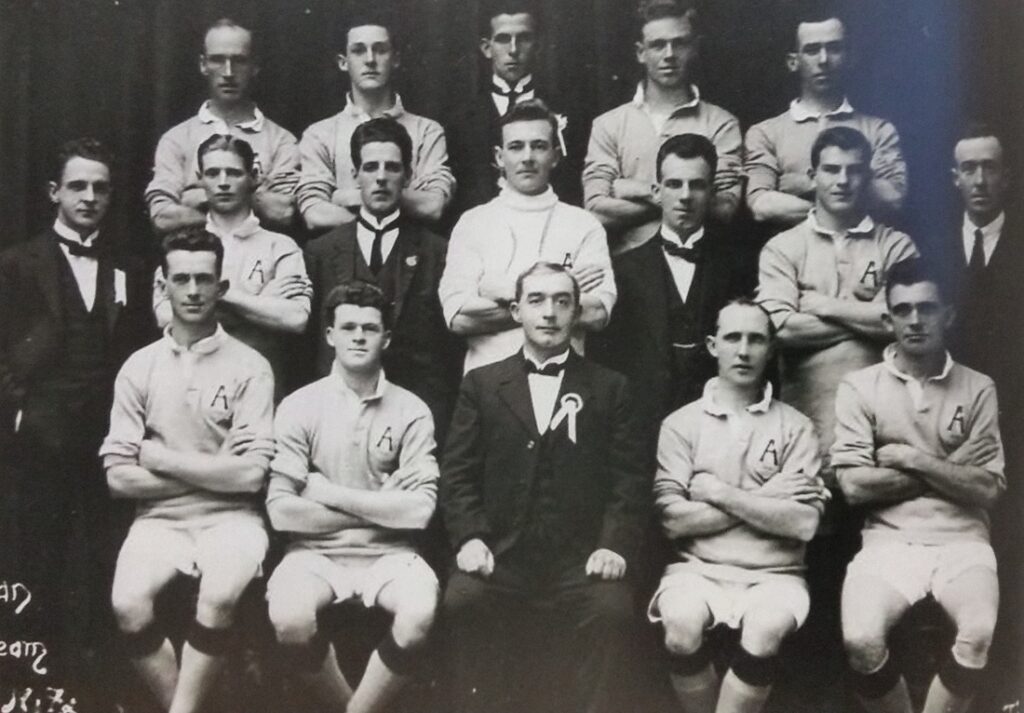
The next time the two sides met, the sprit of the ANZAC narrative had taken hold. With the horror’s of war and bond of camaraderie still lingering, the trophy was a razor case from a soldier in Gallipoli, mounted on a base of Australian maple and New Zealand honeysuckle with a soccer ball on top.
The popularity of the Australian team soared with every game of the 1923 series against New Zealand. Seven thousand attended the first match in Brisbane. Twelve thousand in Sydney before 14,000 packed the Newcastle Showground. When a team from China toured later that year; “capacity crowds of nearly 50,000 came to see the Chinese at the Sydney Cricket Ground,” historians Roy Hay & Bill Murray report in A history of Football in Australia.
The ANZAC narrative framed games against New Zealand within the boundaries of brotherhood. It also fuelled discontent with the British Empire that seeped into international football rivalries. By 1925, Australia’s relationship with England began to strain. A chief architect was prime minister Billy Hughes, who drummed-up post war nationalism. It was carried further when ANZAC Day was declared a national public holiday under Hughes’ successor, Stanley Bruce and the Australian sacrifice for the military ambitions of the British empire were honoured at a large scale, all at a time when the losses were still raw.
It meant England’s first football tour of Australia was going to attract an enormous following. Some seven years before the infamous “bodyline” cricket series, crowds of 44,000 and 32,000 watched England play in Sydney.
However, the Great Depression brought European tours to a standstill. No games were played in 1929 or 1930. Neither in 1932, 1934 and 1935. A sport comprised predominantly of working class participants was hurt deeply by the financial crisis.
When tours eventually recommenced, the national team’s longstanding relationship with asylum seekers and new arrivals began to take a pivotal step. In 1939, A team from Palestine toured amid the eve of war in Europe and the height of Jewish persecution in Nazi Germany. After games in Australia, six Jewish members of that team applied to stay in Australia. According to historians Roy Hay and Bill Murray; “six of them applied to stay in Australia, three of them served in the war against the Japanese and two of them died in Papua New Guinea.”
Inadvertently Australian football was recruiting for the country’s war effort, while at the same time raising the early question of what it meant to be Australian.
Football didn’t just help assimilate new migrants into life in Australia, it allowed them to flourish in a new society. Teams from Italian, Greek and Jewish migrants had begun sprouting up since the mid 1930s but it was the post-war migration that accelerated the growth of Australian football as Europeans fled for the peaceful, prosperous yet isolated Australia.
Hence, when Australia hosted its first major international sporting competition, non-British migrants were effectively excluded due to government policy. Despite the success of European migrants in football and the broader society, the 1956 Olympics team was entirely comprised of Anglo-Australians. The country’s first opportunity to showcase the first success story of multiculturalism failed. Australia was bundled out of the Olympics in the second round after losing to India 4-2.
“There was and still is a strong sense of being at the forefront of a great cultural adventure, a world leading project of multiculturalism and of having to fight for respect of this concept in a nation with a tortured immigration history from Federation through the White Australia Policy, various humanitarian intakes and all of whom faced varying degrees of xenophobia and racism,” former Socceroo Craig Foster said.
The delayed citizenship for non-British migrants was a direct harm to the national team’s progress. It also created a two-speed economy of the game; ethnic clubs were blossoming by the mid 1950s with the arrival of talented players from prominent Europe clubs while the national team had yet to make its mark on the global stage. That wedge was further divided when the country was banned from FIFA competitions in 1959 for the refusal to compensate European club’s for bringing players to Australia.
By the time the ban was lifted in time for the 1966 World Cup qualifiers, surnames such as Sheinflug and Herczeg were lining-up alongside Warren, Watkiss and Rorke while another post-war migrant from Yugoslavia, Tiko Jelisavcic was the head coach.
As author Joe Gorman wrote in The Death and Life of Australian Soccer; “the game has always been pegged to debates around citizenship, identity and muliticultralism. Soccer in Australia is never just soccer. Soccer’s national question is Australia’s question.”
While the first attempt at World Cup qualification was a humbling lesson, losing 9-2 to North Korea on aggregate, that team became the flagship of multicultural Australia. It also sparked the first major fight for fairer working conditions – one the players would endure for decades.
The hardships the players endured weren’t limited to compensation for forfeited earnings in their jobs, they were directly exposed to the brutality of global conflict. In November 1967, Australia was summoned by the federal government to Saigon during the height of the Vietnam war to play in the Vietnam National Day tournament.
“We really didn’t know what to expect,” Socceroo great Ray Baartz told the Guardian in 2013. “We knew there was a war going on there, but it never did at any stage feel that we were going into a warzone or anything like that. But once we got there, it was a real eye-opener.”
Their role was meant to be ambassadorial, however they were ill prepared for what awaited.
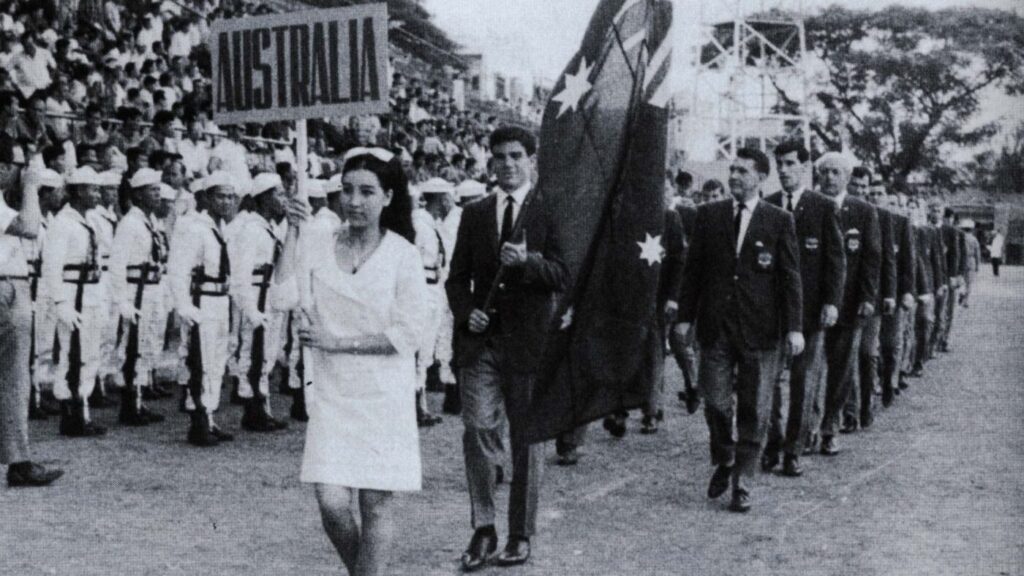
Johnny Warren leads the Australian team during the opening ceremony of the Quoc Khanh Cup in war-torn Saigon: Image credit: Socceroos
“While some of of the team where involved in shooting practice… a ball disappeared into the field behind the goals,” former Socceroo captain Johnny Warren said in his biography; Sheilas, Wogs and Poofters. “As one of the players headed off to jump the fence to retrieve it, people came running from everywhere to stop him. The field was full of land-mines. It was of of the best incentives I have ever encountered to keep shots at goal down during training.”
Staying in the Golden Building hotel in Saigon, the team was embedded with the Australian troops conscripted for battle. The soldiers became part of the team, the players defacto members of the platoon.
“We ended up eating with them most days,” Warren said. “We eventually got to know some of the troops quite well. While they went off to fight, we went out to play football. It was a surreal experience.”
For all the strange conditions, it was a defining moment of the Socceroos. They made a clean sweep of their group, beating South Vietnam, New Zealand and Singapore. An extra-time winner from Baartz secured a 1-0 win over Malaysia in the semi-final to set-up a clash against South Korea in the decider. Billy Vojtek, Johnny Warren and Attila Abonyi scored to clinch a dramatic 3-2 win over the Koreans to help the team lift their first ever international trophy.
Against all odds and amid the height of war, that team showed the grit that would define the future of the national team. They were labelled by a journalist as the The Socceroos, a name that was immediately adopted.
“That’s why the tournament in Vietnam is so special to the guys involved and impermanently connected with the birth of the team that later became known as the Socceroos,” Warren said.
That triumph came at at time of Australia’s changing attitude to race. A few months earlier, in May 1967, a referendum had passed to include indigenous Australians as part of the population. By 1972, the arrival of the Whitlam government shifted Australia’s perspective on migration, it’s relationship with the British Empire and its place within the world. As such, the internationalist Prime Minster turned to football and the Socceroos.
It’s why the first time Advance Australia Fair would be played at a sporting match was before the Socceroos’ match against Uruguay on April 27, 1974 at the Sydney Sports Ground. That team was comprised of Anglo Australians, Indigenous Austrlalians as well as migrants from Hungary, Scotland, Germany and the former Yugoslavia. A richly multi-cultural team were the fitting flag-bearers for the new Australia especially as they were on their way to a first-ever World Cup.
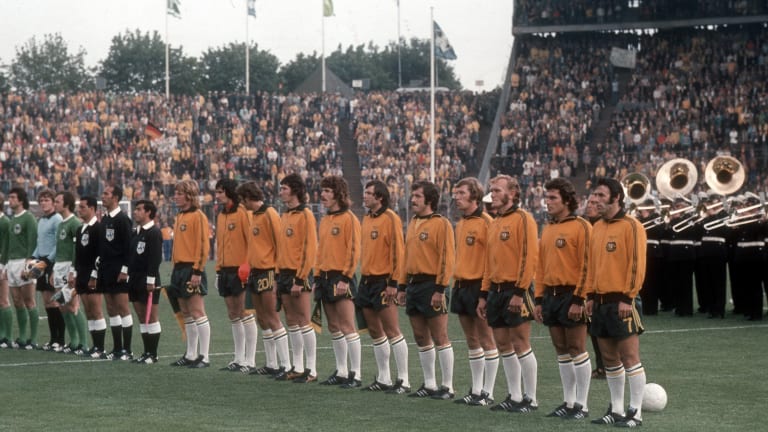
They left the Germany World Cup without a win or a goal but a brave showing adored them further to the country. Unfortunately, it came at the cost of the blue-collar squad. Captain Peter Wilson worked in the coal mines. Manfred Schafer was a milkman, Jim Mackay a tiler and Branko Buljevic a fitter and turner and John Watkiss a scrap metal dealer.
“I lost about four jobs to be able to follow my dream of playing for Australia,” Abonyi told SBS in 2017.
The low pay standards didn’t increase. Remunerations from the Australian Soccer Federation was far below player sacrifices while workplace conditions, travel standards remained well-below that afforded to other touring national teams.
For all the feuds with the administration, the team remained at the forefront of Australia’s identity. Tellingly, Australia celebrated its bicentenary with a football tournament where the Socceroos were the centrepiece.
While the bicentenary was a celebration of British colonialism, the sport of migrants remained Australia’s window to the world. In 1988, Brazil, Argentina and Saudi Arabia played the Socceroos in Sydney and Melbourne. Australia lost 1-0 to Romario’s Brazil. They then routed Saudi Arabia 3-0 before stunning World Champions Argentina 4-1.
“We all can recall where we were when Captain Charlie Yankos lashed perhaps the greatest free kick in Socceroos history against then World Champions,” Foster said. “That team played their role in the progression of the male team, and game more broadly, through a focus on competitive mentality and with some players that would be superstars today, had the ability to match the aggression.”
For all their strengths, the World Cup remained elusive since 1974. After five failed attempts, Australia was on the cusp of qualifying for the 1998 World Cup in France, with a home and away match against a less-fancied Iran all that stood in the way. But it came at a time of turmoil. At home, Australia’s working class was in the crosshair of a new regime. John Howard was elected prime minister in March 1996 on a platform of industrial reform. In particular, he took aim at unions.
“We can never build greater productivity unless we have fundamental industrial relations reform,” Howard said in February 1996. “We are opposed to compulsory unionism. Our industrial relations reform, which will be the cornerstone of our policy to reduce the operating costs of business.”
At the time the unions of ports and wharf workers were on the path to the infamous strikes, Australia’s football players too were forced to unionise. In the aftermath of Australia’s failed qualification for the 1998 World Cup – the infamous defeat to Iran on away goals at the MCG – the Socceroos’ players took industrial action that would forever change the shape of the national team.
“Qualification was not meant to be with a bizarre and devastating night at the MCG however in hindsight, the game was not ready and quite likely, the financial windfall would have entrenched an ethically bankrupt administration,” Foster said. “Change was desperately needed and the players were already committed to that change.”
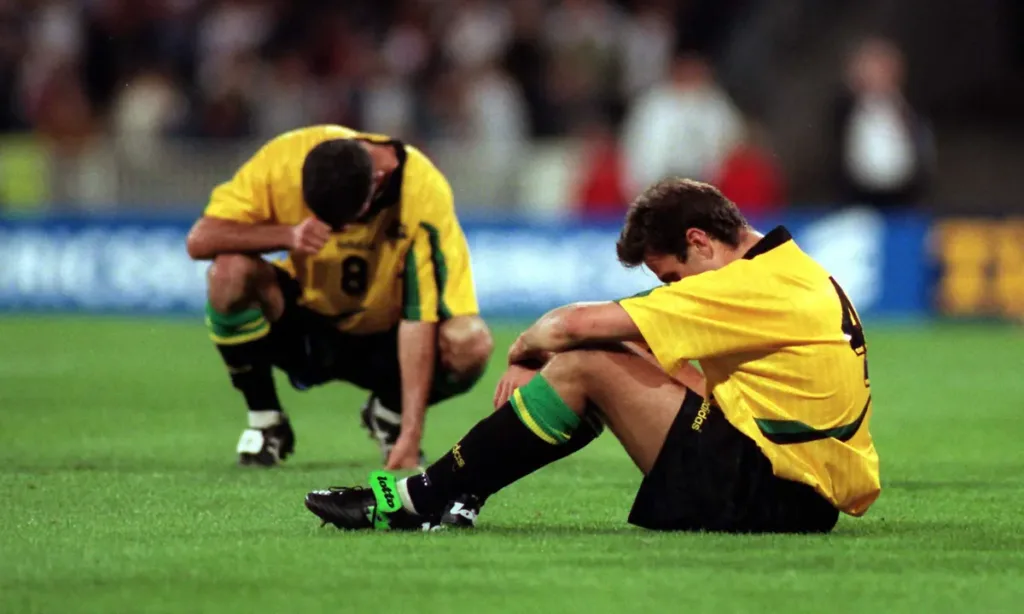
Just a month after the devastating draw to Iran in Melbourne, the Socceroos were to play in the Confederations Cup in Saudi Arabia. There, “the players had been led to believe that there was big prize money for the Confederations Cup, and expected to receive a fair share. David Hill, however, refused to increase their share of the largesse,” Gorman wrote in The Death and Life of Australian Soccer.
The Australian Soccer Player’s Association [now Professional Footballers Australia] had been founded four years earlier but the Confederations Cup was its red-letter moment. On the eve of the tournament, all-but three players voted to strike in favour of better conditions.
“We were the first generation of unionized players and the majority of us felt a strong responsibility to raise standards across the entire game, having seen the best of what football could be globally and with immense belief in our own capabilities as Australians,” Foster said.
The players boycotted training yet performed brilliantly in games. They drew with Brazil, beat Mexico and Uruguay to finish runners-up, all the while engaged in the most significant industrial dispute in the national team’s history.
“While challenging for fans at that time, seeing their Socceroos threaten not to play in a major tournament, we won critically important gains that gave the players a direct voice, entrenched conditions that would contribute to qualification eight years later, and gave us a seat at the table to build the game, not just play it,” Foster said.
“That action supported every player in Australian financially, enabled the PFA to become a leading player in the growth of the game and would eventually lead to equal pay between the Matildas and Socceroos. The majority of players were prepared to risk their international careers for the wellbeing of their younger and not-yet-born professional colleagues, and for the game to fulfil its potential.”
It laid the professional platforms for the Socceroos’ eventual qualification for the 2006 World Cup. The standards improved thereafter as the team qualified for every World Cup to date. Throughout, the sense of sacrifice and duty has remained as strong as in 1967 and 1997.
“You’re setting an example to future generations, so you have to go out there and represent the green and gold with pride and leave it all out there,” Socceroo Brett Holman said.
For a hundred years, the Socceroos have continued to challenge Australia’s sense of self. The class of 2022 may stand on the shoulders of giants but they still represent more Australians, and more about Australians than any other team
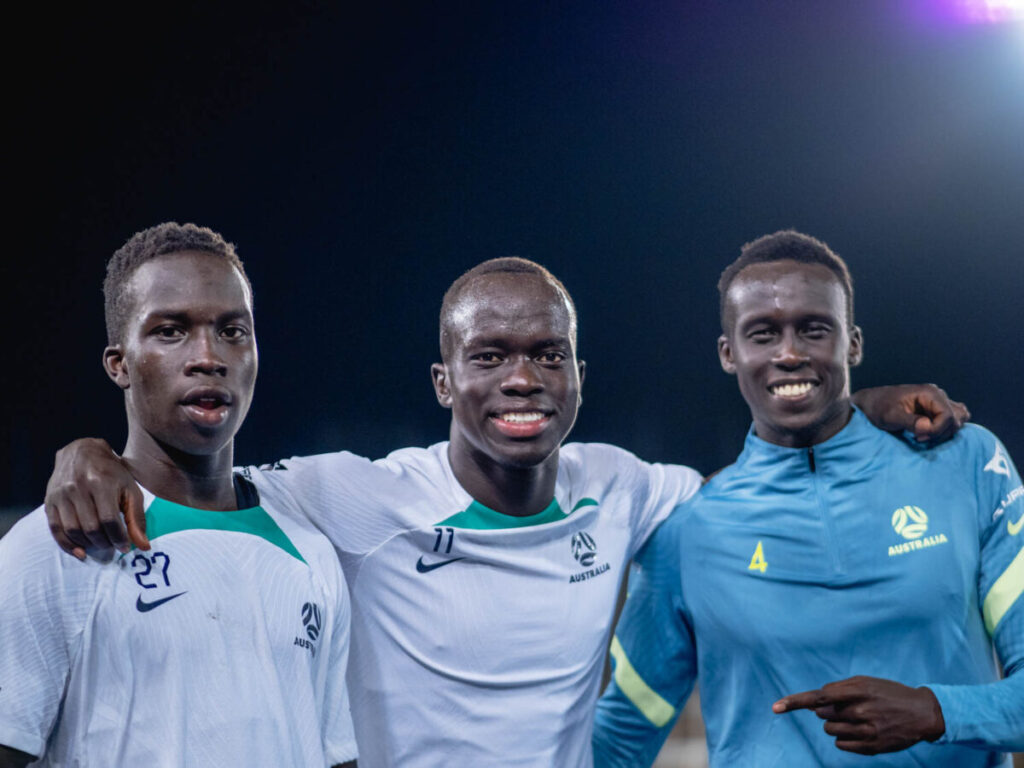
“The game has reached a stage of broader cultural embeddedness and the younger generation sees our teams as perfectly normal. As the Socceroos evolve, so too does the nation,” Foster said. “
“Our destinies have always been intertwined.”







